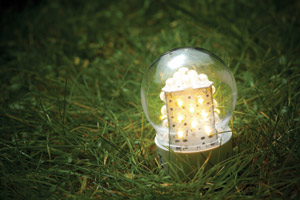The operation will be greener and the bottom line healthier.
 When it comes to foodservice design, the U.S. Green Building Council's (USGBC) Leadership in Energy and Environmental Design (LEED) certification is the most recognizable symbol for conservation — and with good reason. LEED certification represents the commitment of the foodservice operator — and its design, building and management teams — to not only construct or renovate a facility in a responsible manner but to continue to embrace that philosophy during its operation.
When it comes to foodservice design, the U.S. Green Building Council's (USGBC) Leadership in Energy and Environmental Design (LEED) certification is the most recognizable symbol for conservation — and with good reason. LEED certification represents the commitment of the foodservice operator — and its design, building and management teams — to not only construct or renovate a facility in a responsible manner but to continue to embrace that philosophy during its operation.
But pursuing LEED certification is no simple task. The USGBC has a significant series of steps foodservice operators need to complete to ensure that their facilities embrace the spirit of sustainability and actually live up to it in practice. In other words, earning LEED recognition is not something that comes easily.
And for a variety of reasons, the decision whether to pursue LEED certification on a given foodservice design project, search for another third-party certification program, or, instead, to simply use the best practices and guidelines that LEED has inspired is a complex one.
Overshadowed in all of this, though, is the simple fact that green initiatives have become primary drivers when building and renovating foodservice facilities. And that's good news both for the industry and the environment.
That's because the twin enterprises of sustainability and efficiency continue to define green. Most operators want to take advantage of new equipment and processes that will save them money and give them bragging rights for being green.
The old maxim that says "you can do well by doing good" is at work in commercial kitchens and dining rooms across the nation. Operators are "doing good" by following guidelines to sustainability and are "doing well" by realizing savings from the resulting efficiencies. This trend toward greening foodservice continues to gain momentum as operators find several paths to achieving the goal.
Taking the LEED
Lisa Stanley is vice president of product management at the USGBC. She notes that there are a number of sound business reasons to become LEED certified, including results that allow operators to improve performance, reduce operational and maintenance costs, receive rebates and tax incentives, demonstrate corporate social responsibility and respond to changing consumer expectations and demographics.
The latter result is a growing phenomenon and, to date, exists primarily in the young adult demographic. Research has shown that brand loyalty can increase in this demographic if a business demonstrates that it is reducing its carbon footprint.
Stanley also explains that LEED certification is a useful tool for every type of foodservice operator. Larger operations, such as chain restaurants, or institutional sites, such as colleges and universities, use and benefit from the Volume Certification. And smaller businesses can still reap the benefits of LEED guidelines and measurements to build and operate a green facility. Either way, foodservice operators will be rewarded with a return on their investment, Stanley says. And as the market evolves, the time needed to recoup that return is getting shorter.
The LEED Retail Rating System for New Construction has specific guidelines for kitchen equipment. The latest version of the LEED rating system (Version 4) is coming out by the end of the year and will address issues in LEED for Operations and Maintenance.
Initiating the Process
The ideal time to start the LEED process or any sustainability initiative, says Nahum Goldberg, LEED AP, senior associate at Cini-Little International in San Pablo, Calif., is "before any hard lines are put on paper." A new design generally means a clean slate, which results in a cleaner process. "You need to talk about the flow, the receiving, and the interface with guests in a new building," he says. For a renovation, you need to discuss "access issues, limits on ventilation, plumbing and electrical. These all have their different challenges."
LEED certifying requirements even involve the external environment of the foodservice location. Site development issues include location, for instance whether the site is easily accessible by public transportation, pedestrians or bicycle riders. Some foodservice operators even offer charging stations for electric vehicles. If a restaurant delivers, electric delivery vehicles will make a positive environmental statement.
Other considerations developers might include are surfacing walkways and constructing parking areas with sustainable materials that will allow storm water to permeate the surface, reducing run off. A green roof will help control rain run off and can actually reduce heat absorption by the building, reducing energy consumption. Although a "green wall" is not part of the certification checklist, many chefs will plant a wall of herbs for use in food preparation.
In the front of the house, interior design and construction can follow a number of LEED guidelines. LED lighting is commonly in use, saving wattage and extending the life of lamps, thereby saving money and the labor to change bulbs. It also is reported to offer a brighter and better light than fluorescent bulbs. This helps in the back of the house in prep and storage areas, as well. Use of sustainable and recycled materials for woods, carpets and adhesives also improves the environmental quality of the dining room.
In the back of the house, foodservice operators can choose from any number of innovative solutions to prevent wasting energy and water. Notoriously hogs of both resources, most kitchens feature areas ripe for improvement.



